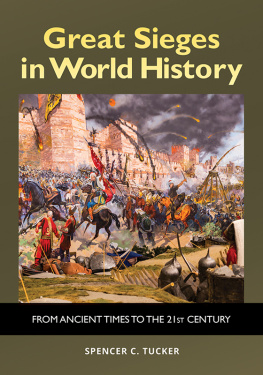Tucker Spencer C. - Great Sieges in World History: from Ancient Times to the 21st Century
Here you can read online Tucker Spencer C. - Great Sieges in World History: from Ancient Times to the 21st Century full text of the book (entire story) in english for free. Download pdf and epub, get meaning, cover and reviews about this ebook. year: 2021, publisher: ABC-CLIO, LLC, genre: History. Description of the work, (preface) as well as reviews are available. Best literature library LitArk.com created for fans of good reading and offers a wide selection of genres:
Romance novel
Science fiction
Adventure
Detective
Science
History
Home and family
Prose
Art
Politics
Computer
Non-fiction
Religion
Business
Children
Humor
Choose a favorite category and find really read worthwhile books. Enjoy immersion in the world of imagination, feel the emotions of the characters or learn something new for yourself, make an fascinating discovery.
- Book:Great Sieges in World History: from Ancient Times to the 21st Century
- Author:
- Publisher:ABC-CLIO, LLC
- Genre:
- Year:2021
- Rating:4 / 5
- Favourites:Add to favourites
- Your mark:
- 80
- 1
- 2
- 3
- 4
- 5
Great Sieges in World History: from Ancient Times to the 21st Century: summary, description and annotation
We offer to read an annotation, description, summary or preface (depends on what the author of the book "Great Sieges in World History: from Ancient Times to the 21st Century" wrote himself). If you haven't found the necessary information about the book — write in the comments, we will try to find it.
Great Sieges in World History: from Ancient Times to the 21st Century — read online for free the complete book (whole text) full work
Below is the text of the book, divided by pages. System saving the place of the last page read, allows you to conveniently read the book "Great Sieges in World History: from Ancient Times to the 21st Century" online for free, without having to search again every time where you left off. Put a bookmark, and you can go to the page where you finished reading at any time.
Font size:
Interval:
Bookmark:

Great Sieges in World History
Copyright 2021 by ABC-CLIO, LLC
All rights reserved. No part of this publication may be reproduced, stored in a retrieval system, or transmitted, in any form or by any means, electronic, mechanical, photocopying, recording, or otherwise, except for the inclusion of brief quotations in a review, without prior permission in writing from the publisher.
Library of Congress Cataloging-in-Publication Data
Names: Tucker, Spencer, 1937 author.
Title: Great sieges in world history : from ancient times to the 21st century / Spencer C. Tucker.
Description: Santa Barbara : ABC-CLIO, 2021. | Includes bibliographical references and index.
Identifiers: LCCN 2020023129 (print) | LCCN 2020023130 (ebook) | ISBN 9781440868023 (hardcover) | ISBN 9781440868030 (ebook)
Subjects: LCSH: SiegesHistory. | Military history.
Classification: LCC D25.5 .T77 2021 (print) | LCC D25.5 (ebook) | DDC 355.4/409dc23
LC record available at https://lccn.loc.gov/2020023129
LC ebook record available at https://lccn.loc.gov/2020023130
ISBN:978-1-4408-6802-3 (print)
978-1-4408-6803-0 (ebook)
25 24 23 22 211 2 3 4 5
This book is also available as an eBook.
ABC-CLIO
An Imprint of ABC-CLIO, LLC
ABC-CLIO, LLC
147 Castilian Drive
Santa Barbara, California 93117
www.abc-clio.com
This book is printed on acid-free paper 
Manufactured in the United States of America
For Robert Keefe,
dear friend, accomplished editor,
and master of print production
Contents
This study of 100 great sieges begins with that of Troy (c. 11941184 BCE) and concludes with that of Mosul (2017). Obviously, there are thousands of sieges from which one could choose. I have tried to provide a range of sieges throughout history. I endeavored to provide a mix of time periods, and this worked out as follows: 12 from the Ancient period, 10 from the Early Modern period, 4 from the Renaissance, 31 from the Early Modern period, and 43 from the Modern period. Some of these might appear at first glance to be unusual selections, but they all had important repercussions in influencing subsequent policies and events. All my selections are generally accepted by scholars as sieges, although the besieged often received reinforcements and so were not always completely cut off from outside assistance.
The entries are not of equal length. Some of the entries, especially those in more recent times, are longer, in part because of the increased amount of information available about them. I have, however, endeavored to stay out of the weeds, so to speak, and concentrate on the broader outline as opposed to identifying all units involved and their commanders, which is a temptation in the case of later events where so much more is known.
I have in each case, however, provided background information on the course of events leading up to the siege as well as discussing the siege itself and its consequences. Each siege entry also has a list of books for further reading, and there are 25 sidebars that provide material related to many of the sieges, such as a particular weapons system, innovation, or interesting fact.
I am grateful to distinguished military historians Colonel Jerry Morelock, PhD, U.S. Army Rtd., and Major General David Zabecki, PdD, U.S. Army Rtd. They reviewed my initial entry list and made many helpful suggestions. I am also grateful for the other scholars writing for ABC-CLIO. Of the 100 entries, I have written 85 myself; 6 are shared with another author, and 9 are by other authors. All are identified as such.
Spencer C. Tucker
The word siege is derived from the Latin word sedere, meaning to sit. A siege involves the effort by a military force to blockade a city, fortress, or enemy position with the intent of securing its submission, either by cutting off its food or water supply, thus starving it out, or by taking it by assault. Both methods might be applied simultaneously. It is, however, rare for a besieger to completely cut off some access to friendly forces by the besieged, especially in the present day, given aircraft.
A siege occurs when an attacking force encounters either an enemy population center or military strong point that cannot be taken by an immediate assault and that rejects surrender. The besieging force will endeavor to surround the enemy position, cutting it off from outside communication and reinforcement or resupply but also to prevent the forces in the targeted position from escape. This process is known as an investment.
Once investment has occurred, the attacking force seeks to reduce the besieged fortifications by means of siege engines in the Ancient and Early Medieval periods or with the advent of gunpowder weapons, by artillery fire. Another tactic, employed into modern times, is by digging mines (also known as sapping) to tunnel into an enemy position or using these to set off powerful explosive charges to destroy part of the enemy defensive wall or position to enable access for attacking infantry, as in the Battle of the Crater in the siege of Petersburg (18641865) during the American Civil War (18601865) and in the siege of the Alczar in Toledo (1936) during the Spanish Civil War (19361939). Deception or treachery have also helped bring victory on occasion for the besieger.
Many sieges have been decided by starvation, thirst, or disease. Weather can also play a role. Such factors can certainly affect the attacking force, as well as the besieged, as in the case of the British siege of Cartagena de Indias in 1741. Starving an enemy force into submission can be a long process, however, and depending on circumstances, it can take months and even, on occasion, years.
If possible, the attacking forces would carry out circumvallation. This is the process whereby the attacking army constructs a line of fortifications facing and circling around a besieged city. Besieging armies used this fortified line to protect themselves against sorties by those in the city as well as to enhance their own blockade. The resulting fortifications were known as lines of circumvallation and were mostly of earthen ramparts and entrenchments.
In contravallation, the besieging forces would build a second fortified line facing outward in order to protect themselves from attacks by forces allied to those of the besieged city and to enhance the blockade. The resulting fortifications were known as lines of contravallation and also usually consisted of earth ramparts and entrenchments paralleling those of lines of circumvallation facing toward the besieged city. This enveloped the city in a double line of fortifications and doubly protected the besiegers, who might, however, then find themselves besieged within their lines of circumvallation and contravallation. Julius Caesar (10044 BCE) and the Romans were masters of this, with the outstanding example of the double lines being Caesars siege of Alesia in Gaul, in 52 BCE. Union Army Major General Ulysses S. Grant also employed contravallation in his siege of the Confederate stronghold of Vicksburg in 1863, during the American Civil War.
Ancient cities in the Middle East show archaeological evidence of having had fortified city walls. During the Warring States era of ancient China (481/403221 BCE), there is both textual and archaeological evidence of prolonged sieges and siege machinery employed against the defenders of city walls. In this early period from 600 to 400 BCE, siege warfare failed to keep pace with fortification. Unless they could be starved out in a protracted siege, or be taken by ruse or betrayal, walled cities were generally safe from an enemy attack.
Font size:
Interval:
Bookmark:
Similar books «Great Sieges in World History: from Ancient Times to the 21st Century»
Look at similar books to Great Sieges in World History: from Ancient Times to the 21st Century. We have selected literature similar in name and meaning in the hope of providing readers with more options to find new, interesting, not yet read works.
Discussion, reviews of the book Great Sieges in World History: from Ancient Times to the 21st Century and just readers' own opinions. Leave your comments, write what you think about the work, its meaning or the main characters. Specify what exactly you liked and what you didn't like, and why you think so.










